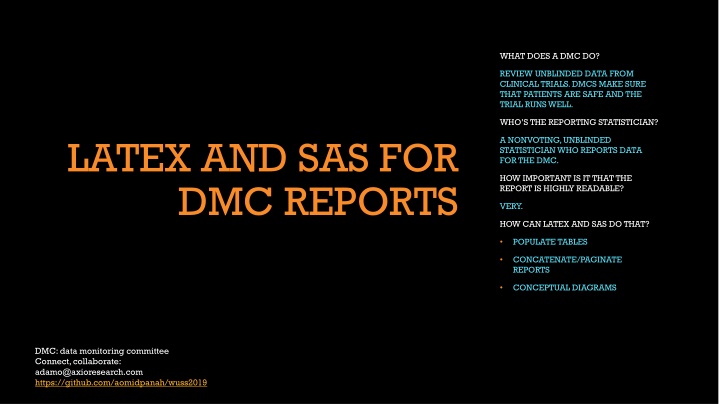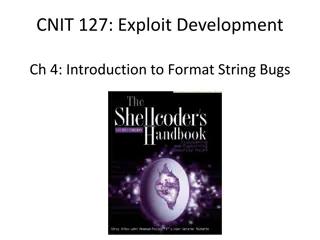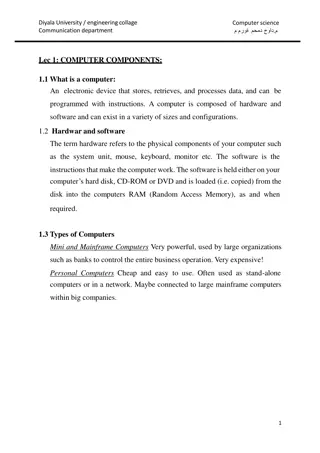
Generating Highly Readable DMC Reports Using LaTeX and SAS
"Learn how to create clear and concise Data Monitoring Committee (DMC) reports by utilizing the power of LaTeX and SAS. Discover the best practices for formatting, populating tables, and curating metadata to ensure readability and effectiveness for DMC review processes."
Uploaded on | 3 Views
Download Presentation

Please find below an Image/Link to download the presentation.
The content on the website is provided AS IS for your information and personal use only. It may not be sold, licensed, or shared on other websites without obtaining consent from the author. If you encounter any issues during the download, it is possible that the publisher has removed the file from their server.
You are allowed to download the files provided on this website for personal or commercial use, subject to the condition that they are used lawfully. All files are the property of their respective owners.
The content on the website is provided AS IS for your information and personal use only. It may not be sold, licensed, or shared on other websites without obtaining consent from the author.
E N D
Presentation Transcript
WHAT DOES A DMC DO? REVIEW UNBLINDED DATA FROM CLINICAL TRIALS. DMCS MAKE SURE THAT PATIENTS ARE SAFE AND THE TRIAL RUNS WELL. WHO S THE REPORTING STATISTICIAN? LATEX AND SAS FOR DMC REPORTS A NONVOTING, UNBLINDED STATISTICIAN WHO REPORTS DATA FOR THE DMC. HOW IMPORTANT IS IT THAT THE REPORT IS HIGHLY READABLE? VERY. HOW CAN LATEX AND SAS DO THAT? POPULATE TABLES CONCATENATE/PAGINATE REPORTS CONCEPTUAL DIAGRAMS DMC: data monitoring committee Connect, collaborate: adamo@axioresearch.com https://github.com/aomidpanah/wuss2019
MUST BE START-TO-FINISH PROGRAMMATICALLY CAPABLE FORMAT FOR READABILITY: Is sans serif font actually easier to read? Studies say no Are you removing decimal-trailing zeros by skipping formatting statements? PRINCIPLES OF DMC REPORT GENERATION Section labels and numbers must make sense within the document Clickable hyperlinks and lightweight document formats make for easy reading and scanning Figures are quicker to read but can miss crucial details Ignoring y-scale, x-scale Omit axis labels Solution: tables are the best complement and suffice on their own REPORT SHOULD BE PRINTABLE BELOW ARE COMMON CHALLENGES WITH SIMPLE SOLUTIONS.
LATEXS TABULAR ENVIRONMENT IS POWERFUL, HIGHLY CUSTOMIZABLE. ODS OUTPUT PROC REPORT AND USE DATA _NULL_ STEP TO MAKE LATEX TABLE CODE. data _null_; *; set textable2 nobs = n; file "C:\MyTex.tex" dlm="&"; Separate tabular entries with & and end line escape \\ . Export table procedures like PROC EXPORT normally would work well, using & to delimit entries. But no custom end-of-line escape yet. if _n_ = 1 then do; put "\documentclass{standalone}"; put "\begin{document}"; put "\begin{tabular}{lrrrrr}"; put "& & & & \multicolumn{2}{c}{Treatment received} \\"; put "Geographic Region & Enrolled & Randomized & Exposed to treatment & Red & Blue \\ \hline"; end; POPULATING TABLES put region enrlfn2 randfn2 saffn2 _c5_2 _c6_2; if _n_ = n then do; put "\hline \end{tabular}"; put "\end{document}"; end; run; GIVES THIS OUTPUT BELOW:
CURATE METADATA FILE WITH TITLE, ANNOTATIONS, LAST RUN TIMES, USE SAS TO MAKE MASTER LATEX FILE FROM METADATA CONCATENATE proc import datafile="&dir.metadata.xlsx" out=toc dbms=xlsx replace; run; data _null_; set toc; val = "\section{" || strip(title) || "}" || "\input{" || strip(basename) || ".tex}"; put val; run; \input will source LaTeX files and apply document wide formatting. Alternately see \include. AND PAGINATE REPORTS \includepdf from the PDF pages package(\usepackage{pdfpages}) is best for unmodified inclusion of single table within a report. COMPILE MASTER LATEX FILE, OUTPUT AS BELOW:
CONCEPTUAL DIAGRAMS ARE DIFFERENT FROM FIGURES: THEY USE OBJECTS AND RELATIONS RATHER THAN SCALES AND TRENDLINES CONSORT DIAGRAMS ARE POPULAR FOR A) REMINDING THE DMC OF THE STUDY DESIGN AND B) ANNOTATING THE SUBJECT DISPOSITION SAS/LATEX SOLUTION: SIMPLY USE MACROS AND TIKZ proc sql; select count(distinct usubjid) into :enr from adam.adsl; select count(distinct usubjid) into :blue from adam.adsl where saffl = "Y" and trt01a = "Blue"; quit; CONCEPTUAL DIAGRAMS %let tikz = \documentclass{article} \node (enr) {Enrolled \\(N=&enr)}%quote(;) & \\ \node (ran) {Randomized \\(N=&ran)}%quote(;) & \\ \path (ran) -- (exp) %quote(;) \path (exp) -- (red) %quote(;) \path (exp) -- (blue) %quote(;) GIVES THE FOLLOWING OUTPUT:











